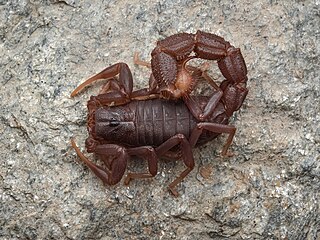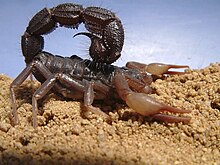
Parabuthus transvaalicus is a species of venomous scorpion from semi-arid parts of southern Africa.

Delta atracotoxin is a low-molecular-weight neurotoxic polypeptide found in the venom of the Sydney funnel-web spider.
Kurtoxin is a toxin found in the venom of the South African scorpion Parabuthus transvaalicus. It affects the gating of voltage-gated sodium channels and calcium channels.
Tityustoxin is a toxin found in the venom of scorpions from the subfamily Tityinae. By binding to voltage-dependent sodium ion channels and potassium channels, they cause sialorrhea, lacrimation and rhinorrhea.
Birtoxin is a neurotoxin from the venom of the South African Spitting scorpion. By changing sodium channel activation, the toxin promotes spontaneous and repetitive firing much like pyrethroid insecticides do
Bestoxin is a neurotoxin from the venom of the South African spitting scorpion Parabuthus transvaalicus. Most likely, it targets sodium channel function, thus promoting spontaneous and repetitive neuronal firing. Following injection into mice, it causes non-lethal writhing behaviour.
BmKAEP is a neurotoxin from the venom of the Manchurian scorpion (Mesobuthus martensii). It is a β-toxin, which shift the activation voltage of sodium channels towards more negative potentials.
Altitoxin is a neurotoxin found in the South African scorpion Parabuthus transvaalicus. Injection of altitoxin in mice leads to akinesia, depression and death.
Dortoxin is a lethal peptide toxin which is secreted by the South African spitting scorpion Parabuthus transvaalicus. Injection of pure dortoxin in mice leads to hyperactivity that lasts until death.
Raventoxins are neurotoxins from the venom of the spider Macrothele raveni.
Huwentoxins (HWTX) are a group of neurotoxic peptides found in the venom of the Chinese bird spider Haplopelma schmidti. The species was formerly known as Haplopelma huwenum, Ornithoctonus huwena and Selenocosmia huwena. While structural similarity can be found among several of these toxins, HWTX as a group possess high functional diversity.
CSTX is a name given to a group of closely related neurotoxic peptides present in the venom of the wandering spider Cupiennius salei. There are twenty types so far described for this protein group. However, some are reclassified into cupiennins group of toxin, including CSTX-3, -4, -5, and -6, because of their chemical affinity. The first thirteen were isolated and identified in 1994 by Lucia Kuhn-Nentwig, Johann Schaller, and Wolfgang Nentwig of the Zoological Institute at the University of Bern, Switzerland. The different types are most likely the products of splicing variant of the same gene. They are all L-type calcium channel blockers, and also exhibit cytolytic activity by forming an alpha-helix across the cell membrane in mammalian neurons. They also inhibit voltage-gated calcium channels in insect neurons.
Hemitoxin (HTX; α-KTx6.15) is a 35-mer basic peptide from the venom of the Iranian scorpion Hemiscorpius lepturus, which reversibly blocks Kv1.1, Kv1.2 and Kv1.3voltage-gated K+ channels.
BotIT2 is a neurotoxin from the scorpion Buthus occitanus tunetanus, which modifies activation and slows down the deactivation of voltage gated sodium channels.
Centruroides suffusus suffusus toxin II (CssII) is a scorpion β-toxin from the venom of the scorpion Centruroides suffusus suffusus. CssII primarily affects voltage-gated sodium channels by causing a hyperpolarizing shift of voltage dependence, a reduction in peak transient current, and the occurrence of resurgent currents.
HgeTx1 (systematic name: α-KTx 6.14) is a toxin produced by the Mexican scorpion Hoffmanihadrurus gertschi that is a reversible blocker of the Shaker B K+-channel, a type of voltage-gated potassium channels.
Beta-mammal toxin Cn2, also known as Cn2 toxin, is a single chain β-scorpion neurotoxic peptide and the primary toxin in the venom of the Centruroides noxius Hoffmann scorpion. The toxin specifically targets mammalian Nav1.6 voltage-gated sodium channels (VGSC).
Ts8 is a neurotoxin present in the venom of the Brazilian yellow scorpion, Tityus serrulatus. Ts8 is a selective inhibitor of the voltage-gated potassium channel Kv4.2
Tb1 is a neurotoxin that is naturally found in the venom of the Brazilian scorpion Tityus bahiensis. Presumably by acting on voltage-gated sodium channels, it triggers excessive glutamate release, which can lead to both behavioral and electrographic epileptiform alterations, as well as neuronal injury.
Tityus stigmurus toxin 1 (Tst1) is a neurotoxin found in the venom of the Brazilian scorpion, Tityus stigmurus. It acts on voltage-gated sodium channels (Navs), altering opening and inactivation voltages, recovery from inactivation, and overall current flow.


